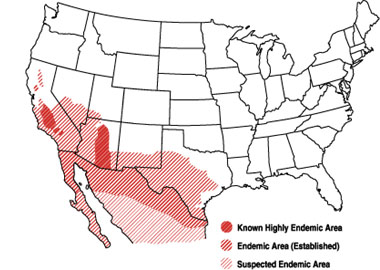If you’re new to Arizona , you probably haven’t heard the term Valley Fever. In reality, you might not ever hear it, even if you do live in Phoenix for many years. However, it is important to have an understanding of what Valley Fever is, what the symptoms of Valley Fever are, when you should visit a Phoenix physician and what Valley Fever treatment options are. So, let the physicians at Family Practice Specialistswalk you through the basics of Valley Fever.
All About Valley Fever
While Valley Fever is a hot topic here in Arizona , seen by many Phoenix doctors, it is not particular to our state. In fact, this year California is expected to see it’s worse onset of Valley Fever in years.
Medically speaking, Valley Fever is a lung infection – a virus that is transferred through the dust in the air, which is why Arizona is such a hotbed for Valley Fever. High agricultural areas, such as Southern California , are also hotbeds for the virus, where the wind can churn up dust from the desert as well as farmland.
While Valley Fever is not extremely dangerous, if left untreated it can become deadly. Symptoms of Valley Fever include the following (from MayoClinic.com):
• Fever
• Cough
• Chest pain — varying from a mild feeling of constriction to intense pressure resembling a heart attack
• Chills
• Night sweats
• Headache
• Fatigue
• Joint aches
• Red, spotty rash
It is estimated that 1 out of every 33 Arizona residents in Phoenix-metro areas and lower desert areas like Tucson will have had Valley Fever at some time in their lives. According to a recent article in USA Today , nationwide, the number of valley fever cases rose by more than 850% from 1998 through 2011, according to the Centers for Disease Control and Prevention. In 2011, there were nearly 22,000 cases, with most cases reported in California and Arizona .
The article goes on to say that Arizona saw an incredibly steep rise in Valley Fever cases from 1998 to 2011, from 1,400 cases to 16,400 cases. If you live in Maricopa county, Pima county or Pinal county, you are at a greater risk for contracting Valley Fever.
Detecting and diagnosing Valley Fever eludes many Phoenix doctors. In fact, nearly 50% of all Valley Fever cases will go undiagnosed. Symptoms like fever, coughing and soreness are often associated with the flu, and can easily be confused when it comes to diagnosis.
Treatment for Valley Fever in Phoenix is usually just rest and relaxation – a little R&R. If symptoms do not subside, your Phoenix doctor might recommend antifungal medications.
Take it from the expert doctors at Family Practice Specialists, the best medicine for Valley Fever is prevention. This summer, if there is dust in the air, an incoming dust storm, or an exceedingly windy day, stay indoors and close yoru windows. This will not only prevent Valley Fever, it will prevent a host of allergens from invading your house during allergy season as well.
If you think that you might have Valley Fever, give us a call today!
4350 E. Camelback Rd.
Ste F100
Phoenix, AZ 85018
602.955.8700
Summary:
If you’re new to Arizona, you probably haven’t heard the term Valley Fever.
However, it is important to have an understanding of what Valley Fever is, what the symptoms of Valley Fever are, when you should visit a Phoenix physician and what Valley Fever treatment options are.
While Valley Fever is a hot topic here in Arizona, seen by many Phoenix doctors, it is not particular to our state.
Medically speaking, Valley Fever is a lung infection – a virus that is transferred through the dust in the air, which is why Arizona is such a hotbed for Valley Fever.
Symptoms of Valley Fever include the following (from MayoClinic.com):














